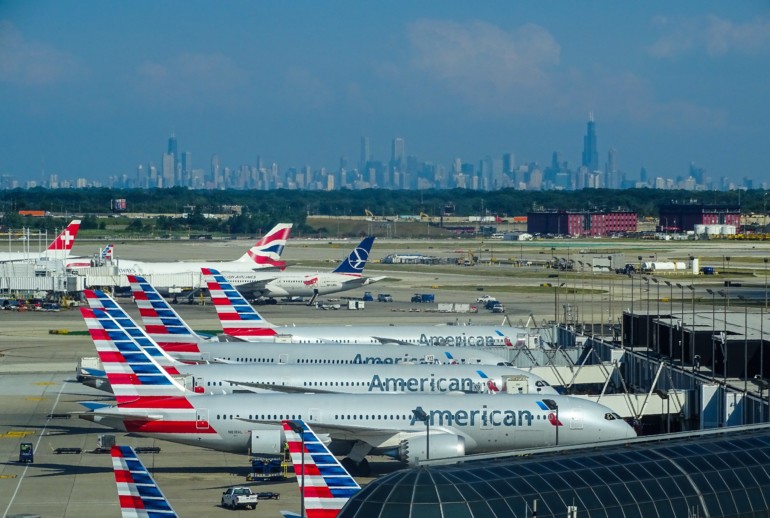Business and leisure travel have blurred together to form “bleisure” travel, according to two titans in the travel industry, Mark Hoplamazian, President and CEO of Hyatt Hotels, and Robert Isom, CEO of American Airlines. Together, with moderator Phil LeBeau, Auto and Airline Industry Reporter for CNBC, these experts in the travel space discussed the future of tourism, especially as it pertains to the city of Chicago. Members and sponsors of Executives’ Club of Chicago were in attendance at this in-person one-hour discussion at the Hyatt Regency Chicago on May 11.
One thing was absolutely clear, even though the tourism industry has suffered quite a blow given two years of a global health crisis, there’s a hopeful positivity surrounding the outlook of travel and tourism as we move into the next quarter. Borders are reopening, supply and demand is increasing, and, according to those at the top, the projections look good.
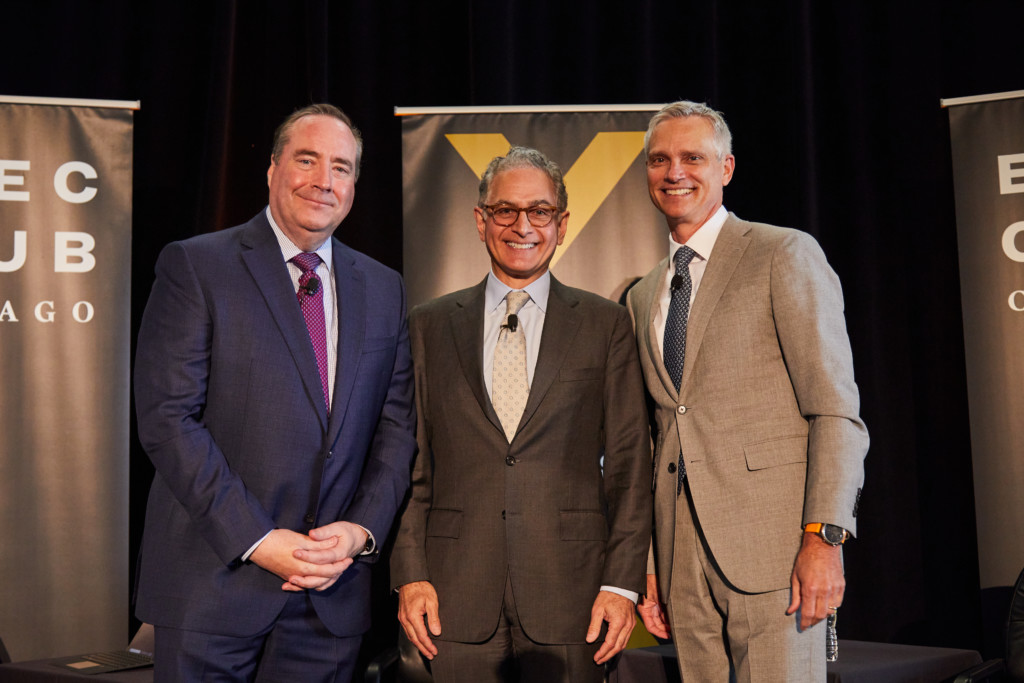
As for the Windy City? While Chicago seems to be lagging a bit behind other travel markets, mostly because tourism in our city relies heavily on large-scale business conferences and exhibits that haven’t come completely back online yet, Hoplamazian and Isom both believe that the future is bright. When Chicago’s demand increases, they’ll be there as investments in the city haven’t stopped.
Margaret Mueller, President and Chief Executive Officer of Executives’ Club of Chicago opened the floor with introductions of the board and gratitude for members and sponsors of the club (including Tom Ricketts, Chairman of the Chicago Cubs). Established before World War I, The Executives’ Club of Chicago has a long and rich history of shaping Chicago business and providing a platform for thought leadership.
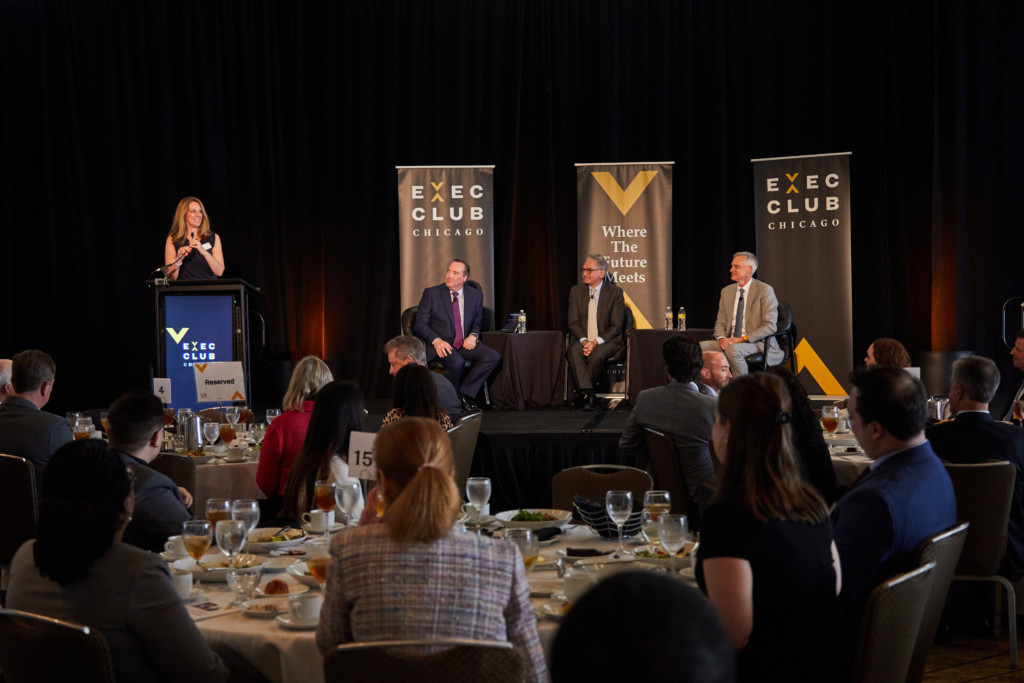
Scott Swanson, President of PNC Bank in Illinois took the stage to introduce Hoplamazian and Isom. Swanson briefly mentioned the major transformation O’Hare is set to endure.
Here are 12 key takeaways from the one-hour luncheon:
Empathy + Action = Care
“Travel is a fundamental desire to explore and be together,” Hoplamazian said as he waxed poetic about purpose and care in the travel industry. “The reason we became friends fast (Robert Isom) is because of conversations we had around purpose.”
Hoplamazian talked about how we’ve lived through the most severe thing in our industry where businesses evaporated overnight. “You have to change your mindset,” he said. “We build tremendous muscles for adaptability and agility.” Figuring things out, then, depends on how malleable one can be. You can’t be rigid in this industry, and you must be able to pivot. “There’s not a rigid playbook,” he says, “there’s an agile playbook and you learn at speed.”
Hoplamazian goes on to say that every conversation he had with Isom either started or ended with a dialogue about people. He wants to understand mental wellbeing, practicing empathy, and making sure that he can understand people to really care for them. “Our organizations are culturally aligned that way,” Hoplamazian says. Resiliency has been such a major player, Hoplamazian says, that even if something were to go south again, the adaptability and resiliency gained gives him confidence to move forward.
Hospitality = One Out of Every Seven Open Jobs
“Wages are up across the board, with higher revenues and higher margins,” says Hoplamazian. Group business is up in rate. “There are signs of life,” he says.
Isom says that as we went into March, traffic really exploded, even with different variants and things going on in Europe. Price of fuel has doubled in the last six months, which is a huge expense, but it’s supply and demand. Travel is an affordable endeavor right now. “I am not concerned about us out pacing the type of demand that’s out there,” says Isom.
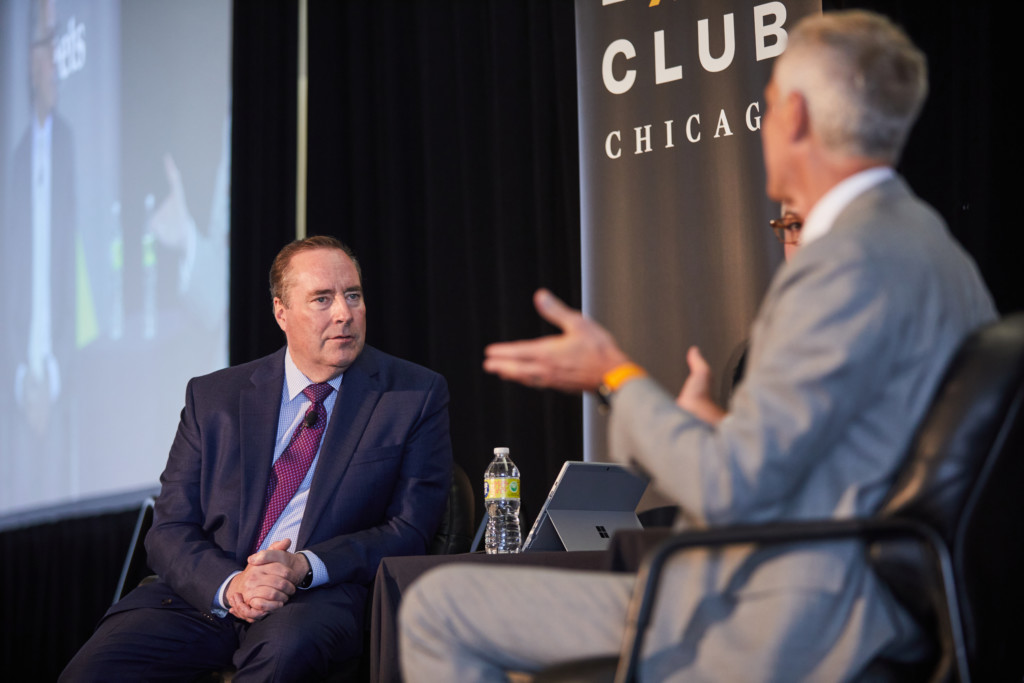
Second Quarter is Mapping out to Be Better than the First Quarter
Hoplamazian is seeing a tremendous demand with rates going up for Memorial Day and Fourth of July. “People are now really worried that they won’t find a place to stay,” he says.
Group Business is Coming Back
“Group business is coming back with a vengeance,” says Hoplamazian. “Data demonstrates that group businesses will be fully recovered to pre-pandemic levels by the end of this year.”
“Everybody is getting back into the office,” says Isom. “We’re catching up.”
“Long gone are the days that you’ll get an empty seat on a flight,” says LeBeau.
Recovery in the Tech Cities is Lagging
“Chicago is behind the curve with respect to people being back in the office,” says Hoplamazian. This has to do with the kinds of jobs that are being allowed to operate remotely.
“We never took a hiatus from the office,” says Isom. “American Airlines has had a tough time over the last two years, and we had to do creative things. If you’re not pushing for business, someone else is.”
Mask and Travel Mandates Have Made an Impact
LeBeau posited, “There seems to be a northern plateau, where the mask mandates were in place longer, longer than the sun belt. Do you see a lag there in the return to work with full activity?”
“It’s true for Chicago,” says Hoplamazian. “There’s definitely been an impact.”
“Whether it was testing or masking, as soon as a restriction was pulled down, bookings changed the next day,” says Isom. “Pull testing getting back into the U.S. and that will help Chicago.”
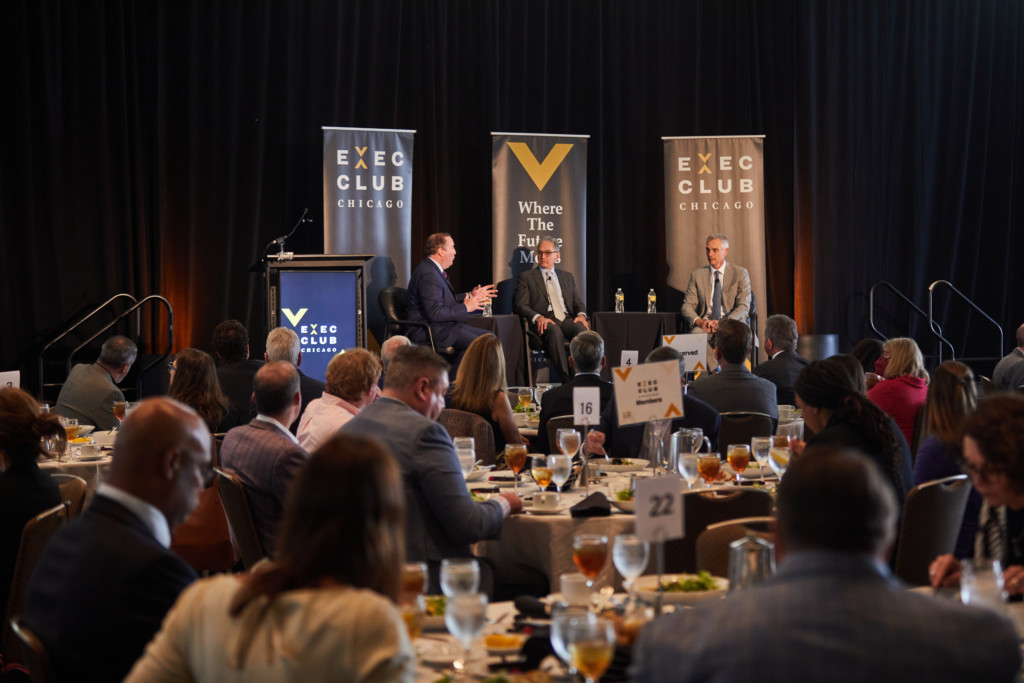
Digital Tools Have Propelled the Industry
“A lot of companies, us and a lot of competitors, turn to digital tools with contactless capabilities,” says Hoplamazian. “You need more engineers and code writers, data and analytics folks. Everyone added to those teams to build up tools.”
Defining Customers Has Changed
“How has the pandemic changed how you define your customer?,” asked LeBeau. “Do you define them as business versus leisure? Is there hybrid?”
Hoplamazian says that they’re seeing an increase in occupancy on Sunday and Thursday nights, which by his assessment means that people are starting their business trips earlier, staying the weekend, and blending buisness with leisure. “There’s blurriness,” he says. “We need to subsegment our customer base. Defining customers as only business or leisure is an antiquated calculation. “Data helps us understand why people are traveling with a new lens,” he says. “There’s more blending.”
“Bleisure is real,” says Isom. Leisure costumers have changed too. Leisure travelers want the same amenities that they’re used when traveling for business.
Chicago Is a Major Player, Yet Lags in Recovery
“We have a large presence in Chicago,” says Hoplamazian. “Our market share in Chicago is second out of all the major brands. We’re not changing our focus on Chicago, but Chicago is lagging in recovery. We’ve seen other cities come back more strongly. International travel isn’t open fully. This city is so dependent on large conventions and that is not back in full motion. That has to be a huge focus.”
“American has so much investment in Chicago,” says Isom. “We have to have a supply of passengers. The investment hasn’t stopped. When the city comes back, we’re going to be there.”
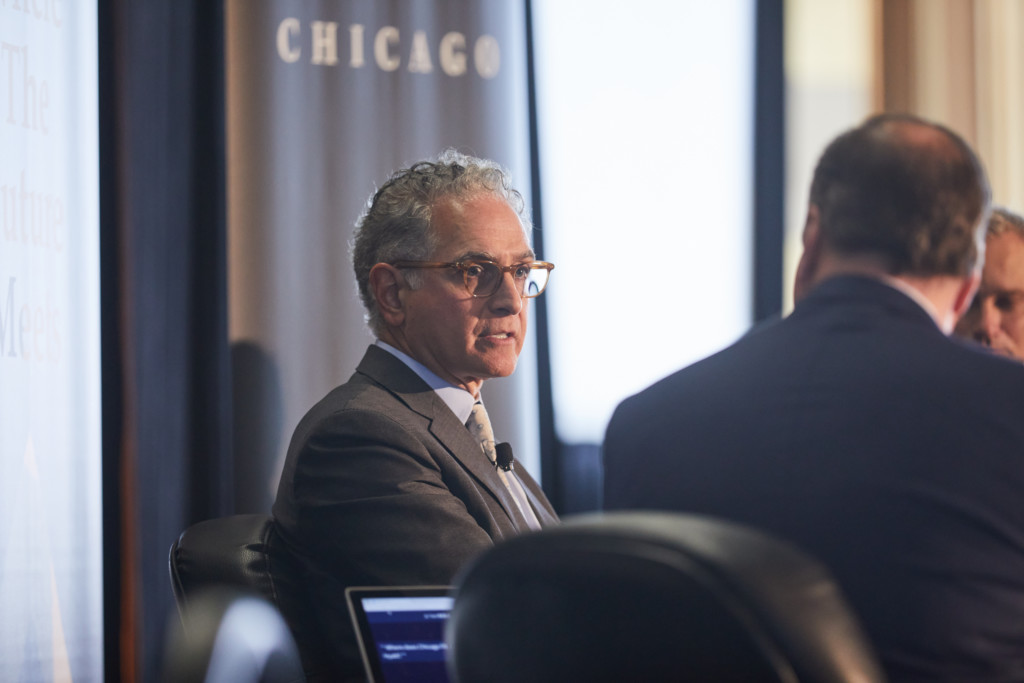
There Are Good Times and Bad
“You’ve seen good times bad times, recessions, how does this time compare to previous times. Does it give you a road map? Or is it so unusual and unique because of the pandemic and inflation?” asks LeBeau.
Isom says, “We’re looking at a profitable second quarter. It’s one of demand and return. If you don’t run your businesses with the mindset of growth and prosperity, I don’t know how you go about it. I know demand will return. We’ve made a commitment to the country based on the benefits we received. We’ll be out there to serve.”
Sustainability Is a Key Factor
When asked about sustainability and what the future looks like, Hoplamazian said that goals were set in 2007 and science-based targets have been put in place for 2030. A reduction in greenhouse gases and a carbon footprint is important. “American Airlines have a bigger hill to climb,” he says. “Last I checked, you can’t fly an electric plane.”
Isom replies, “We consume a lot of fossil fuels. It’s front and center and real life. As an airline, we try to burn less fuel by flying the shortest distance, working with air traffic control/government. The investment is something being done over decades.” In addition to burning less fuel, having new engines and planes helps. American Airlines, according to Isom, has invested billions in new planes.
More From Better:
- CSR Spotlight: How Hyatt and other Illinois-Based Hospitality and Travel Companies are Taking Action Against Human Trafficking
- Executive Inclusion and Equity Strategies from a Kellogg Professor to Help Your Business Achieve Sustainable Impact
- Chicago’s Most Powerful Women 2022
- Connecting With a Group Can Take You From Surviving to Thriving — But You Need to Do These 4 Things First
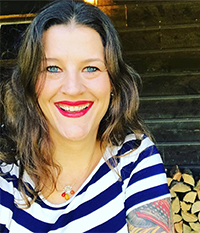
I graduated at the top of my class from DePaul University and I’ve been in the travel industry, writing and exploring the globe, ever since. I’ve worked at a luxury boutique travel company as an itinerary writer, contributed to major daily newspapers and print magazines, and have been contracted at award-winning travel sites. I’ve been a panelist and featured speaker, presenting insider know-how on travel writing and thought leadership. I’ve written stories about: pods of women skydivers, hiking the Grand Canyon rim to rim, learning how to surf in El Salvador and Bali, traveling solo to Dubai and Hong Kong, swimming with whale sharks, teaching kids empathy and respect by trekking through Japan, flying down dirt roads in Sri Lanka in search of pachyderms, and the practice of eating horse meat in Iceland. I’m always looking for the next adventure—especially experiences that involve interacting with locals, learning about different cultures, and opting outside. www.wendyaltschuler.org
